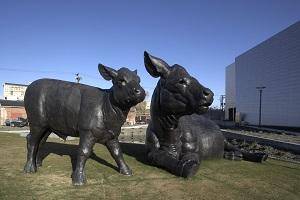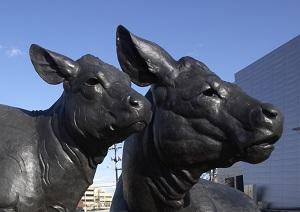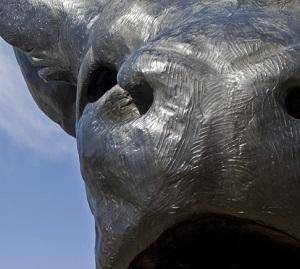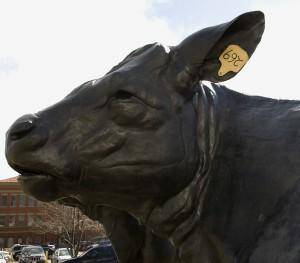Students will use Dan Ostermiller's Scottish Angus Cow and Calf as primary source material to inspire secondary language arts skills. After analyzing the sculpture, they will write a children’s book that tells the story of these two animals.
Students will be able to:
- use imagery and symbolism, coupled with explanations about the sculpture from the About the Art section, to inspire writing;
- participate in and contribute to discussions regarding the sculpture; and
- craft a story of their own using the work of art as the subject and integrating qualities they observe in the work of art.
Lesson
- Display the image of Scottish Angus Cow and Calf so that it is visible to the entire class.
- Give the students the name of the sculpture, the name of the artist, and the time period in which the sculpture was created, and have them view and analyze it. Encourage them to be specific in their observations and ask them to consider elements discussed in the About the Art section, such as the scale/size, color, technique, expressive nature, patina, exaggeration of form, pairing, texture, and gold touches.
- Write the following assignment on the board: Write a short children’s book (the teacher can determine the length depending on the age group of his/her students) based on these cows, integrating visual qualities of the sculpture into the story. The story should include the following literary elements: theme, characterization, storyline (with concluding events), setting, protagonist, and antagonist.
- Give students an appropriate amount of time to complete their stories. You might also want to allow the students to complete the story as homework.
- Follow-up: If students feel comfortable, ask for volunteers to share their stories in the class.
Materials
- Lined paper and a pen or pencil for each student
- About the Art section on Scottish Angus Cow and Calf
- One color copy of the image (or one copy for each student), or the ability to project the image onto a wall or screen
Standards
- Visual Arts
- Invent and Discover to Create
- Observe and Learn to Comprehend
- Relate and Connect to Transfer
- Language Arts
- Oral Expression and Listening
- Research and Reasoning
- Writing and Composition
- Reading for All Purposes
- Collaboration
- Critical Thinking & Reasoning
- Information Literacy
- Invention
- Self-Direction
Scottish Angus Cow and Calf
- Dan Ostermiller, American, 1956 -
- Work Locations: Colorado
As the son of a noted taxidermist in Cheyenne, Wyoming, Dan Ostermiller grew up surrounded by animal forms. By training and working as a taxidermist himself, Ostermiller gained a strong understanding of the body language and anatomy of animals. Technical accuracy became second nature to him and provided him with the foundation to create artwork that is both realistic and expressive. He relocated to Loveland, Colorado, in the 1970s to be near the fine art foundries, where metal is melted and molded. Since then he has created over 312 original sculptures (over 40 at monumental scale, of which our Cow and Calf is the largest), and his studio works on 50 to 100 pieces at any given time.
For Scottish Angus Cow and Calf, Ostermiller began by creating a 30-inch bronze maquette (a small-scale version to use as a model) from photographs of the cows. Once the form of the sculpture was determined, it had to be enlarged to colossal scale. In order to determine the scale needed for the sculpture, Ostermiller moved several trucks around on the ranch and then viewed them from up to a half-mile away. From the bronze maquette, Ostermiller made a plaster version, placed it on a grid, and cut it into thin sections. Each slice was reproduced large-scale in Styrofoam, then matched up on a giant grid on the floor of his studio. The slices were then carved down and smoothed together to recreate the form of the cow. Ostermiller sent molds of the 13 different panels to a foundry in New York to be cast into bronze, and the bronze panels were returned to his Loveland studio unfinished. Because it was winter, Ostermiller wanted to assemble the cow inside. But he knew that once she was put together in the studio, she wouldn’t be able to fit out the door. He had to cut her apart in sections and reassemble her outside. He went through the same process to create the calf.
Ostermiller was commissioned to create Scottish Angus Cow and Calf by Leo Hindery, a Colorado ranch owner who wanted to commemorate the cows of his own beloved Scottish Angus herd. Scottish Angus cows are bred for their amiable temperament and Hindery pampered his like pets. The cows loved having their heads scratched and were treated to corrals with water misters to keep them cool. They would even come to Hindery when called. Because his property near Larkspur, Colorado, is difficult to access, Hindery promised that he would donate the piece to a public institution if he ever sold the property.
Ostermiller spent some time meeting and photographing Hindery’s cows and found he especially loved the way they lay out in the pasture. Ostermiller avoids the “natural,” dioramalike poses used in taxidermy. These sculptures are supposed to imitate animals in their habitat, but Ostermiller’s animal poses come from his observations of animals and their behavior in his presence. “Whether or not the [animal] is ever in the position I’m using in my piece is secondary because the sculpture is my interpretation, my idea as to what makes a good design for the animal,” says Ostermiller.
Details

Patina
Ostermiller applied chemicals to the bronze to create the black patina, or surface finish.

Size
The whole sculpture is approximately 38 x 22 feet and weighs about 10,000 lbs. (5 tons). The animals are three times life-size, making the cow 13 feet tall. As a joke while making the cow in his Loveland studio, Ostermiller placed his secretary’s desk inside the sculpture.

Exaggeration of Form
To Ostermiller, the quality of shapes and design are of the utmost importance for creating expression, character, and charm. Notice, for instance, the roundness of the cow’s belly, folds of skin, and muscle contours. He says, “Information about animal anatomy is critical to sculpting, but for me, exaggeration of form for the sake of aesthetics is the goal.”

Pairing
Grouping two (or more) animals together is a technique Ostermiller uses to increase the expressiveness of a piece. It allows him to convey intimate involvement and emotional interaction between the subjects and also provides interesting relationships of the forms from different viewpoints.

Texture
Ostermiller says, “Surface textures are important to me. Not the details of cat hair, for instance, but lines and serrations left by tools that direct your eye over the surface planes of the sculpture and throughout its compositions.”

Gold
Each of Hindery’s cows wore a bright yellow ear tag. Ostermiller’s cows also have ear tags, but their color comes from gold plating.
Funding for object education resources provided by a grant from the Morgridge Family Foundation. Additional funding provided by the William Randolph Hearst Endowment for Education Programs, and Xcel Energy Foundation. We thank our colleagues at the University of Denver Morgridge College of Education.
The images on this page are intended for classroom use only and may not be reproduced for other reasons without the permission of the Denver Art Museum. This object may not currently be on display at the museum.







